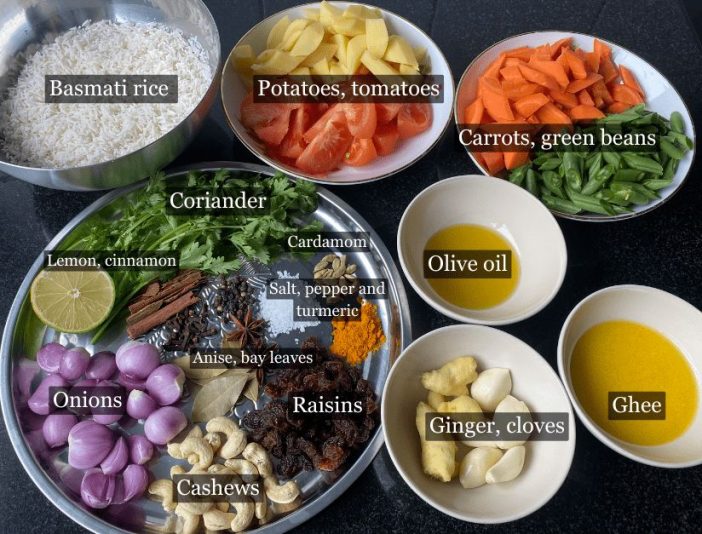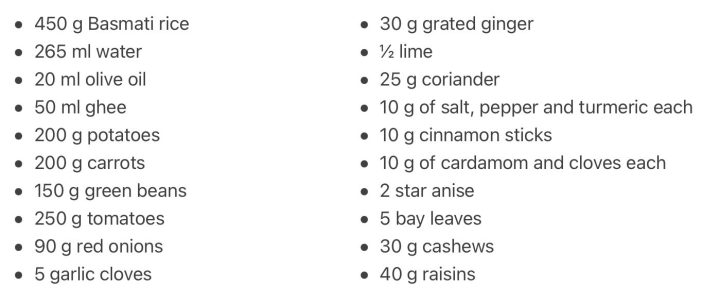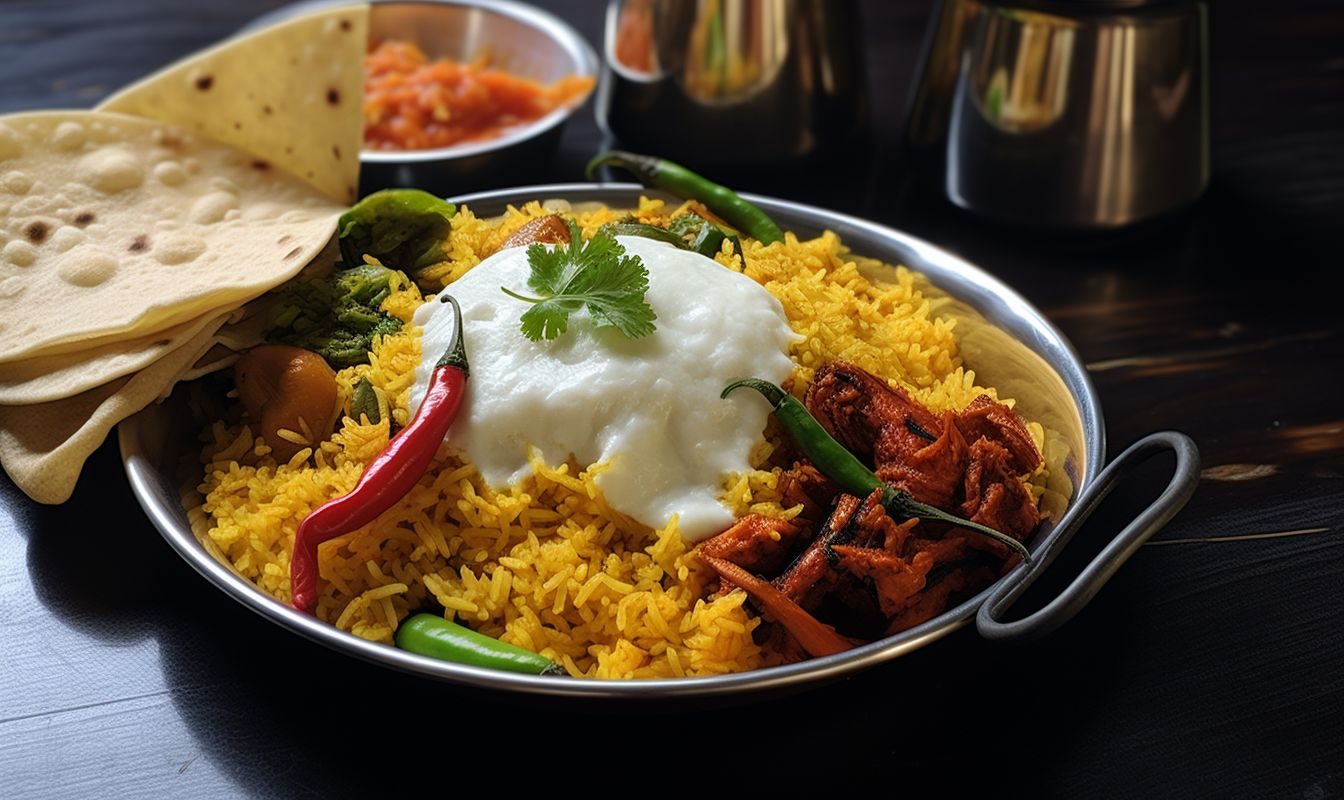Hi, lovely readers! Some meals have the unique power to evoke emotions ?. With every inhale, it not only makes one’s mouth water, but also triggers memories and feelings of comfort and joy. The Biryani, an epic Indian delicacy, is renowned for its ability to bring a sense of relaxation and calmness ??, promoting emotional stability simply through its fragrance.
In my previous blog, we explored Kola Kenda – a Vegan Porridge ? deeply rooted in Sri Lanka’s Buddhist culture, a magical recipe for restoration and rejuvenation, blending Ayurvedic herbs like Gotu Kola. Today, we will dive into the heritage of Biryani, its distinct spices, and the making of the vegetarian Biryani which is bound to soothe the soul.
Please follow the link to the recipe ➡️:
https://www.youtube.com/watch?v=_hQykWp9zDA&t=28s
The birth of Biryani: unveiling its origins
The journey of traditional Indian Biryani began with the arrival of Muslim invaders ?: Turks, Persians, and Afghans, who introduced the culture of feasting to the Indian subcontinent. Culinary practices evolved during their majestic Mughal Empire spanning from 15th to 19th century initiating a variety of gastronomic treasures, including biryani, pilaf, and kebabs. However, historic evidence proves: similar aromatic rice dishes ? were existent, prior to the Mughal invasion, called the “Oon Soru” aimed to feed military warriors. Hence, Indian Biryani can be acknowledged as having emerged from both the Mughal Empire and the kitchens of Indian households.

But, why does Biryani taste different in various regions? As empires rose and fell, so did the biryani, adapting to the ever-changing landscape of India ??. From the royal courts of the Mughals to the slums in Dharavi, each region added its own twist, birthing culinary marvels like the famous Kolkata biryani influenced by the British or the Hyderabadi delight.
Today, biryani is more than just a dish: it’s a reflection of India’s diverse heritage. From the coconut-/ tamarind-infused flavors of the South to the delicate spices of the North, each biryani tells a tale of tradition and creativity.
Exquisite spice ?️ aromas for the unique Biryani experience
Turmeric: Extracted from the root of curcuma longa, turmeric is known for its anti-inflammatory effects and swelling reduction abilities. It enjoys prevalent use in cuisines owning a warm, bitter flavor, enhancing the taste and colour of dishes. Moreover, turmeric assists treating a range of conditions ?, including osteoarthritis, hay fever, indigestion, depression, high cholesterol, nonalcoholic fatty liver disease, and oral mucositis.
Cinnamon sticks: Cherished for their aromatic allure, cinnamon sticks find their inheritance in the inner bark of the cinnamon tree and are popular for their sweet and woody essence ?.These sticks play a profound role in diverse kitchens adding depth to mulled wine or enriching chilli con carne. Among the array of options, organic Sri Lankan cinnamon sticks stand out as a premium choice highlighting a unique sweet taste.
Cardamom: With over 4,000 years of history and as a member of the ginger family, cardamom is renowned for its distinctive spicy-sweet flavour. It finds its place in Indian and Middle Eastern recipes, while the smoky essence of black cardamom complements piquant dishes. Renowned for its essential oils and high antioxidant properties, cardamom also aids in digestion and blood pressure regulation ??♀️.
Cloves: Originating from the Moluccas or Spice Islands of Indonesia, cloves have been an integral part of the spice trade since ancient times. With their intense aroma and spicy taste, cloves are widely used to season? meats and baked goods. Eugenol, the initial component of clove oil, contributes to its characteristic pungency and finds application in various industries, from dental anesthesia to perfumes and flavor enhancers.
Star anise: From the Chinese evergreen tree: Illicium verum, the star anise is prized for its licorice taste. The spice is highy valued in the Chinese medicine ?? and contains antioxidants, anti-inflammatory, and antimicrobial properties. Notably, its shikimic acid content is vital in combating viral infections such as influenza, while its anethole component fights fungi and its antibacterial properties address drug-resistant bacteria and urinary tract infections.
Bay leaves: Sourced from the laurel tree, bay leaves are aromatic herbs available in both fresh, dried or ground into powder forms. Whether utilized dried or fresh, whole bay leaves ? enhance dishes across diverse cuisines, including Indian, Filipino, European, and Caribbean fare. These leaves are added during cooking but removed before serving, and are more commonly used than any other herb.
Crafting the vegetarian Biryani recipe
Follow along with my video on how to make vegetarian Biryani!
? Prep Time: 15 min | ??? Cook Time: 20 min | ⏱️ Total Time: 35 min |?Servings: 3-4
? Ingredients:


? Instructions:
-
- Begin by thoroughly rinsing the Basmati rice three times in a bowl. ?
- Heat a pan and fry the cashews and raisins in ghee until they turn golden. Once done, remove them from the pan and set aside on a plate for later use.
- In the same pan, add olive oil, red onions, pepper, bay leaves, cinnamon sticks, cardamom, and cloves. Allow them to fry until they turn golden. ?
- Once golden, add the star anise to the pan.
- Next, add potatoes ?, carrots ?, and green beans to the pan and let them simmer until they are tender.
- Now, add garlic cloves and grated ginger to the pan.
- After 2 minutes, season with salt and add peeled tomatoes ?.
- Add the rice and turmeric. Stir the Biryani.
- Pour water into the pan and ½ lime juice. ?
- Sprinkle coriander on top, cover the pan with a lid, and let the Biryani cook for 20 minutes.
- After cooking, remove the lid and stir the Biryani to mix all the ingredients well.
- As a final touch, garnish the dish with the fried cashews and raisins.
- Serve the Biryani with yogurt, papadum, and chili while it’s still warm. ?
Now, take the first bite of your Biryani and close your eyes.. Let the aroma carry you on a journey through time ?️ – a journey where every bite is an adventure, and every dish, a story waiting to be told. Thank you for following my blog posts ?!
P.S: To store it longer or prepare this meal ahead of time, you can use insulated food containers for freshness.
Have you experimented with Biryani spices in your cooking adventures? If not, are you tempted to give it a shot? Share your cooking experiences or any helpful tips you may have in the comments below! I can’t wait to hear from you. Stay tuned for an exquisite array of delicious recipes and culinary inspirations in my next video about Paneer thikka Masala and be sure to not miss my blog post on ABC-shots for that post-yoga power boost!
? Fun fact about Henna:
Did you know that henna, also known as Lawsonia inermis or mehndi, has been used for over 5,000 years for its natural dyeing properties and medicinal benefits? Originating from the Middle East and South Asia, henna is an integral part of cultural and religious traditions, symbolizing good health and promising long-lasting marriage ?, while the richness of the henna stain is believed to reflect the depth of love between the couple ??❤️???. Beyond its ornamental use for body art, henna is valued for its antifungal, antibacterial, and cooling properties, making it a versatile ingredient in traditional medicine ?. Furthermore, its vibrant red-orange hue serves as a organic hair dye, offering a safe and eco-friendly alternative to synthetic hair colorants.
Bibliography:
- History of Biryani in India. Biryani By Kilo. (2024, February 19). Retrieved from https://biryanibykilo.com/blog-history-of-biryani-in-india
- Everything You Need to Know About Henna Tattoos. Good Housekeeping. (2024, March 8). Retrieved from https://www.goodhousekeeping.com/beauty/a43623291/henna-design-ideas/
- Henna: Its History and Cultural Significance. St. Thomas University. (2024, February 19). Retrieved from https://www.stu.ca/lnap/henna-its-history-and-cultural-significance/
- Tracing the History of Biryani. India Currents. (2024, February 20). Retrieved from https://indiacurrents.com/tracing-the-history-of-biryani/#:~:text=The%20word%20“biryani”%20comes%20from,who%20inspired%20the%20Taj%20Mahal
- Curcumin: A Review of Its’ Effects on Human Health. National Center for Biotechnology Information. (2024, February 18). Retrieved from https://www.ncbi.nlm.nih.gov/pmc/articles/PMC5664031/
- 6 Facts About Cardamom. Piccantino Magazine. (2024, March 4).Retrieved from https://www.piccantino.com/info/magazine/6-facts-about-cardamom#:~:text=Cardamom%20is%20rich%20in%20essential,because%20it%20stimulates%20the%20metabolism[1].
- Clove Description, History, & Uses. Encyclopædia Britannica. (2024, February 22).Retrieved from https://www.britannica.com/plant/clove[1].
- Star Anise: Benefits, Uses and Potential Risks. Healthline. (2024, February 21). Retrieved from https://www.healthline.com/nutrition/star-anise#benefits[1]
- What Are Bay Leaves — And Do They Really Do Anything? Allrecipes. (2023, February 2). Retrieved from https://www.allrecipes.com/article/what-is-a-bay-leaf/[1].



Yummy! I’ll try it! 🙂
Oh this looks delicious! Definitely going to try this. ?